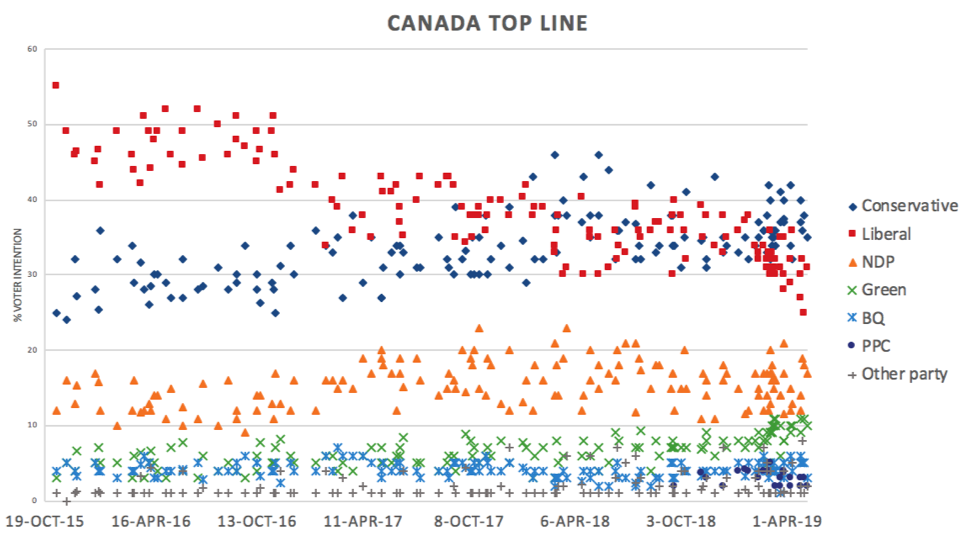By Natalie Pikulski
Canadians are changing their political support which may mean a change in government come fall. Over the next four blog posts, I will examine federal polling data conducted since the last election held on October 9, 2015, up until May 4, 2019. These blogs will attempt to draw connections between trends observed in different demographic groups, compare them to the national average, and discuss any apparent differences to better understand the changes in public opinion toward the federal government over the last 4 years. The four blogs in this series analyze specific demographic trends, in this order; national overall trends, gender, age-groups, and regions. This first blog will outline general trends seen at the national level for all main political parties.
Polling data included in this blog series is based on weighted samples of decided and leaning voters. Only polls with accessible web links were included in our data collection for accuracy and reproduction purposes. We also ensured the polling questions asked in each poll were consistent with other polling organizations’ questions to allow for equal comparisons. Because of the limitations, all Nanos Research polls were not included since the question had respondents choose their top two choices rather than one choice like all other organizations.
At the end of 2016, a little over a year since the federal election, Liberal support was steadily declining while Conservative support was rising. This rise and fall led the gap that was significant for the first year after the election between the two parties to close resulting in a neck and neck competition for most of 2018. The Conservatives eventually took a slight lead in 2019. The national polling data on the graph below shows the voting intentions of decided and leaning voters across Canada.

For a little over a year after the election, Liberal support remained steady between 45% to 50% but at the end of 2016 and beginning of 2017, a noticeable drop to about 35% to 45% support occurred. Although the exact reason is unknown, a considerable number of events occurred around this time that may have individually or cumulatively led to this drop.
A gradual Conservative increase that began to overlap with the Liberals throughout late 2017 to early 2019 saw the party go from 25% – 35% support before 2017 to 30% – 45% after. The fall and rise of each party allowed for the significant gap following the election to eventually close and overlap for a considerable amount of time. In early 2019, a dramatic slide in Liberal support to about 25% – 35% allowed Conservatives to pull forward reaching 35% to almost 45% support in some polls.
Many commentators (1,2,3, 4,5,6) suggest thatthis fall in Liberal support was due to the SNC-Lavalin scandal becoming headline news at this time which may explain why the drop was so sudden and apparent, but more investigation into these claims ought to be explored before a definitive explanation can be made.
Other parties to note briefly are the NDP and Green. The NDP national averages are largely consistent with how the party is performing in regions across Canada, continuous and steady support with no real significant fall or rise since 2016, typically maintaining between 10% – 20% support. Support for the Green Party has been rising nationally, reaching 10% in 2019. This is significant as the party has polling even higher than the Bloc Quebecois since 2018 which is significant as they were pulling relatively similar support after the election at around 5% each. The small but still significant spike in Green support in early 2019 will be something to watch during the upcoming election to see if this popular support will translate into winning seats.
The largest and most apparent trend when analyzing the polling data from the past few years was the significant fall in Liberal support and steady gain of the Conservative vote. The next blog will look at how this fall and gain of Canada’s two main federal parties compare between females and males.
